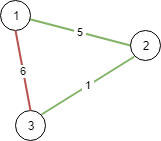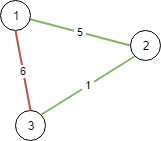There are
N
cities numbered from 1 to
N
.
You are given
connections
, where each
connections[i] = [city1, city2, cost]
represents the cost to connect
city1
and
city2
together. (A
connection
is bidirectional: connecting
city1
and
city2
is the same as connecting
city2
and
city1
.)
Return the minimum cost so that for every pair of cities, there exists a path of connections (possibly of length 1) that connects those two cities together. The cost is the sum of the connection costs used. If the task is impossible, return -1.
Example 1:

Input: N = 3, connections = [[1,2,5],[1,3,6],[2,3,1]] Output: 6 Explanation: Choosing any 2 edges will connect all cities so we choose the minimum 2.
Example 2:

Input: N = 4, connections = [[1,2,3],[3,4,4]] Output: -1 Explanation: There is no way to connect all cities even if all edges are used.
Note:
-
1 <= N <= 10000 -
1 <= connections.length <= 10000 -
1 <= connections[i][0], connections[i][1] <= N -
0 <= connections[i][2] <= 10^5 -
connections[i][0] != connections[i][1]
1、题目描述¶
想象一下你是个城市基建规划者,地图上有 N 座城市,它们按以 1 到 N 的次序编号。
给你一些可连接的选项 conections,其中每个选项 conections[i] = [city1, city2, cost] 表示将城市 city1 和城市 city2 连接所要的成本。(连接是双向的,也就是说城市 city1 和城市 city2 相连也同样意味着城市 city2 和城市 city1 相连)。
返回使得每对城市间都存在将它们连接在一起的连通路径(可能长度为 1 的)最小成本。该最小成本应该是所用全部连接代价的综合。如果根据已知条件无法完成该项任务,则请你返回 -1。
示例 1:

输入:N = 3, conections = [[1,2,5],[1,3,6],[2,3,1]] 输出:6 解释: 选出任意 2 条边都可以连接所有城市,我们从中选取成本最小的 2 条。
示例 2:

输入:N = 4, conections = [[1,2,3],[3,4,4]] 输出:-1 解释: 即使连通所有的边,也无法连接所有城市。
提示:
1 <= N <= 100001 <= conections.length <= 100001 <= conections[i][0], conections[i][1] <= N0 <= conections[i][2] <= 10^5conections[i][0] != conections[i][1]